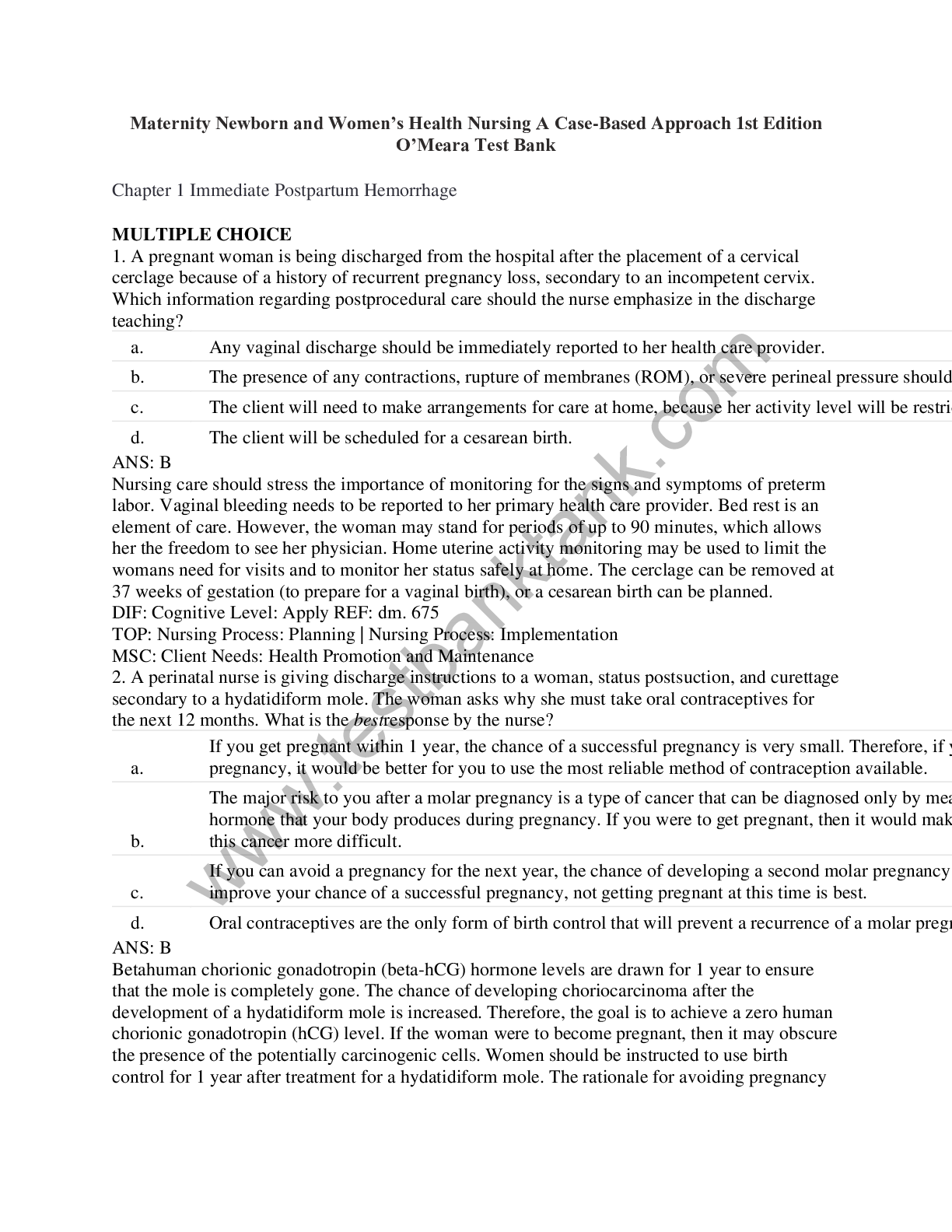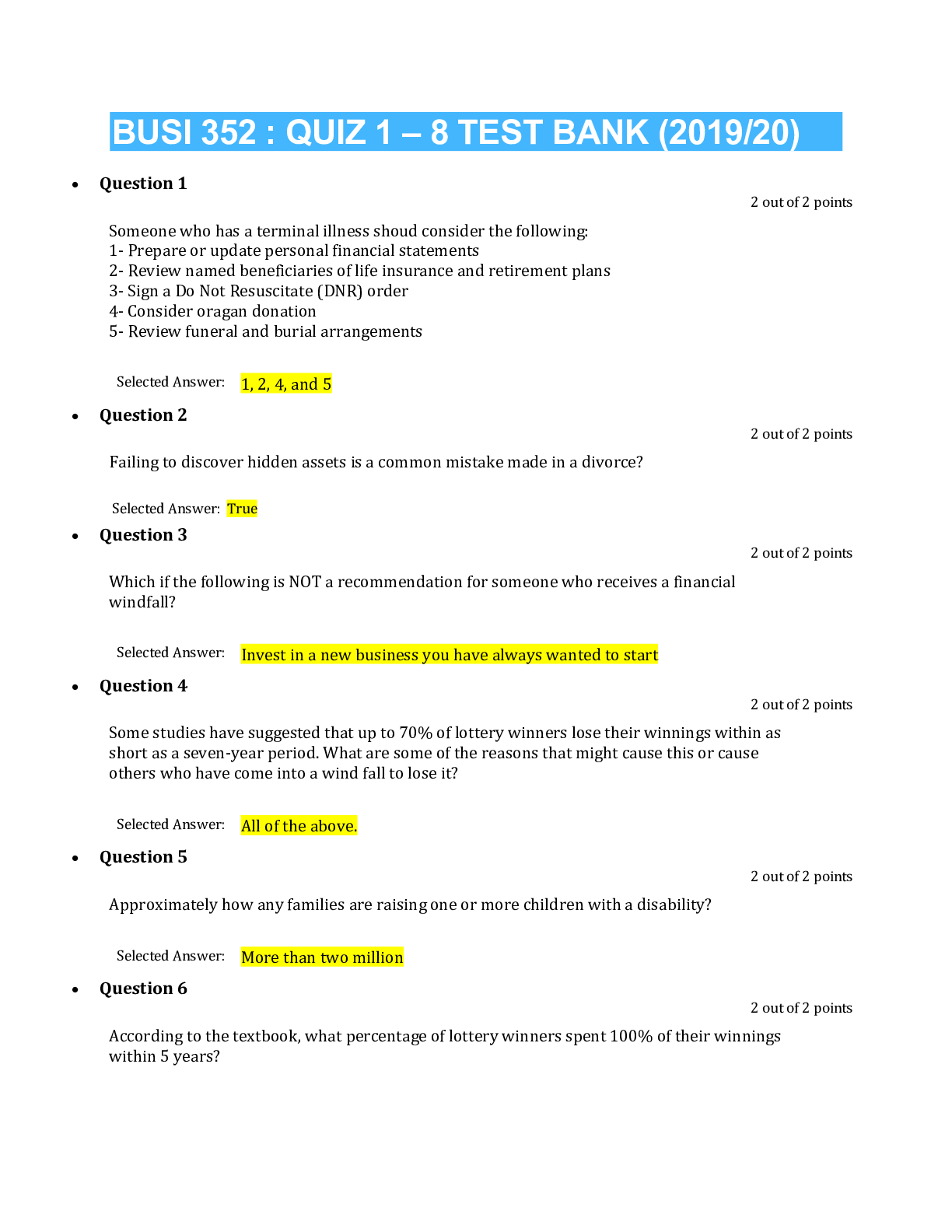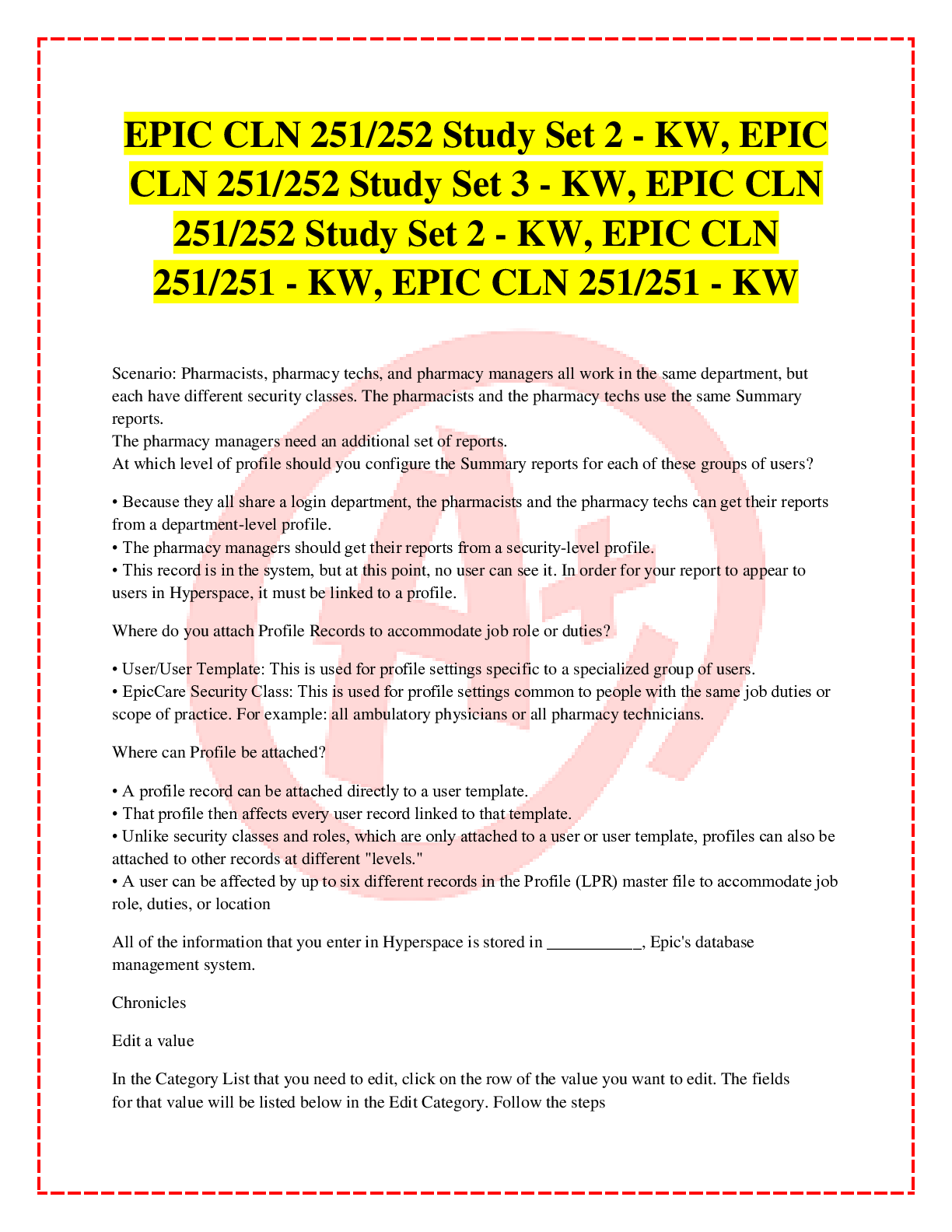Medical Studies > EXAM > Medical-Surgical Nursing, 10th Edition;LEWIS - New! 2020 Updated Complete Exam Bank, Ace on your Stu (All)
Medical-Surgical Nursing, 10th Edition;LEWIS - New! 2020 Updated Complete Exam Bank, Ace on your Studies.
Document Content and Description Below
Lewis: Medical-Surgical Nursing, 10th Edition LEWIS 10th Chapter 38: Assessment of Gastrointestinal System GI BANKS EXAM 1 MS2 Lewis: Medical-Surgical Nursing, 10th Edition **NB this descriptions cont... inues to 240 pages of Genuine A Rated Questions, answers with Rationales.******************* MULTIPLE CHOICE 1. Which information about an 80-yr-old male patient at the senior center is of most concern to the nurse? a. Decreased appetite c. Difficulty chewing food b. Unintended weight loss d. Complaints of indigestion ANS: B Unintentional weight loss is not a normal finding and may indicate a problem such as cancer or depression. Poor appetite, difficulty in chewing, and complaints of indigestion are common in older patients. These will need to be addressed but are not of as much concern as the weight loss. DIF: Cognitive Level: Analyze (analysis) REF: 839 OBJ: Special Questions: Prioritization TOP: Nursing Process: Assessment MSC: NCLEX: Physiological Integrity 2. An older patient reports chronic constipation. To promote bowel evacuation, the nurse will suggest that the patient attempt defecation a. in the mid-afternoon. b. after eating breakfast. c. right after getting up in the morning. d. immediately before the first daily meal. ANS: B The gastrocolic reflex is most active after the first daily meal. Arising in the morning, the anticipation of eating, and physical exercise do not stimulate these reflexes. DIF: Cognitive Level: Apply (application) REF: 836 TOP: Nursing Process: Implementation MSC: NCLEX: Physiological Integrity 3. When caring for a patient with a history of a total gastrectomy, the nurse will monitor for a. constipation. b. dehydration. c. elevated total serum cholesterol. d. cobalamin (vitamin B12) deficiency. ANS: D The patient with a total gastrectomy does not secrete intrinsic factor, which is needed for cobalamin (vitamin B12) absorption. Because the stomach absorbs only small amounts of water and nutrients, the patient is not at higher risk for dehydration, elevated cholesterol, or constipation. DIF: Cognitive Level: Apply (application) REF: 835 TOP: Nursing Process: Assessment MSC: NCLEX: Physiological Integrity 4. The nurse will plan to monitor a patient with an obstructed common bile duct for a. melena. b. steatorrhea. c. decreased serum cholesterol level. d. increased serum indirect bilirubin level. ANS: B A common bile duct obstruction will reduce the absorption of fat in the small intestine, leading to fatty stools. Gastrointestinal bleeding is not caused by common bile duct obstruction. Serum cholesterol levels are increased with biliary obstruction. Direct bilirubin level is increased with biliary obstruction. DIF: Cognitive Level: Apply (application) REF: 847 TOP: Nursing Process: Planning MSC: NCLEX: Physiological Integrity 5. The nurse receives the following information about a 51-yr-old female patient who is scheduled for a colonoscopy. Which information should be communicated to the health care provider before sending the patient for the procedure? a. The patient has a permanent pacemaker to prevent bradycardia. b. The patient is worried about discomfort during the examination. c. The patient has had an allergic reaction to both shellfish and iodine in the past. d. The patient declined to drink the prescribed polyethylene glycol (GoLYTELY). ANS: D If the patient has had inadequate bowel preparation, the colon cannot be visualized and the procedure should be rescheduled. Because contrast solution is not used during colonoscopy, the iodine allergy is not pertinent. A pacemaker is a contraindication to magnetic resonance imaging but not to colonoscopy. The nurse should instruct the patient about the sedation used during the examination to decrease the patient’s anxiety about discomfort. DIF: Cognitive Level: Apply (application) REF: 849 TOP: Nursing Process: Assessment MSC: NCLEX: Health Promotion and Maintenance 6. Which statement to the nurse from a patient with jaundice indicates a need for teaching? a. “I used cough syrup several times a day last week.” b. “I take a baby aspirin every day to prevent strokes.” c. “I use acetaminophen (Tylenol) every 4 hours for back pain.” d. “I need to take an antacid for indigestion several times a week” ANS: C Chronic use of high doses of acetaminophen can be hepatotoxic and may have caused the patient’s jaundice. The other patient statements require further assessment by the nurse but do not indicate a need for patient education. DIF: Cognitive Level: Apply (application) REF: 840 TOP: Nursing Process: Assessment MSC: NCLEX: Physiological Integrity 7. To palpate the liver during a head-to-toe physical assessment, the nurse a. places one hand on the patient’s back and presses upward and inward with the other hand below the patient’s right costal margin. b. places one hand on top of the other and uses the upper fingers to apply pressure and the bottom fingers to feel for the liver edge. c. presses slowly and firmly over the right costal margin with one hand and withdraws the fingers quickly after the liver edge is felt. d. places one hand under the patient’s lower ribs and presses the left lower rib cage forward, palpating below the costal margin with the other hand. ANS: A The liver is normally not palpable below the costal margin. The nurse needs to push inward below the right costal margin while lifting the patient’s back slightly with the left hand. The other methods will not allow palpation of the liver. DIF: Cognitive Level: Apply (application) REF: 844 TOP: Nursing Process: Assessment MSC: NCLEX: Health Promotion and Maintenance 8. Which finding by the nurse during abdominal auscultation indicates a need for a focused abdominal assessment? a. Loud gurgles c. Absent bowel sounds b. High-pitched gurgles d. Frequent clicking sounds ANS: C Absent bowel sounds are abnormal and require further assessment by the nurse. The other sounds may be heard normally. DIF: Cognitive Level: Apply (application) REF: 844 TOP: Nursing Process: Assessment MSC: NCLEX: Physiological Integrity 9. After assisting with a needle biopsy of the liver at a patient’s bedside, the nurse should a. put pressure on the biopsy site using a sandbag. b. elevate the head of the bed to facilitate breathing. c. place the patient on the right side with the bed flat. d. check the patient’s postbiopsy coagulation studies. ANS: C After a biopsy, the patient lies on the right side with the bed flat to splint the biopsy site. Coagulation studies are checked before the biopsy. A sandbag does not exert adequate pressure to splint the site.DIF: Cognitive Level: Apply (application) REF: 850 TOP: Nursing Process: Implementation MSC: NCLEX: Physiological Integrity 10. A 42-yr-old patient is admitted to the outpatient testing area for an ultrasound of the gallbladder. Which information obtained by the nurse indicates that the ultrasound may need to be rescheduled? a. The patient took a laxative the previous evening. b. The patient had a high-fat meal the previous evening. c. The patient has a permanent gastrostomy tube in place. d. The patient ate a low-fat bagel 4 hours ago for breakfast. ANS: D Food intake can cause the gallbladder to contract and result in a suboptimal study. The patient should be NPO for 8 to 12 hours before the test. A high-fat meal the previous evening, laxative use, or a gastrostomy tube will not affect the results of the study. DIF: Cognitive Level: Apply (application) REF: 848 TOP: Nursing Process: Implementation MSC: NCLEX: Physiological Integrity 11. The nurse is assessing an alert and independent 78-yr-old patient for malnutrition risk. Which is the most appropriate initial question? a. “How do you get to the store to buy your food?” b. “Can you tell me the food that you ate yesterday?” c. “Do you have any difficulty in preparing or eating food?” d. “Are you taking any medications that alter your taste for food?” ANS: B This question is the most open-ended and will provide the best overall information about the patient’s daily intake and risk for poor nutrition. The other questions may be asked, depending on the patient’s response to the first question. DIF: Cognitive Level: Analyze (analysis) REF: 841 TOP: Nursing Process: Assessment MSC: NCLEX: Health Promotion and Maintenance 12. A patient has just arrived in the recovery area after an upper endoscopy. Which information collected by the nurse is most important to communicate to the health care provider? a. The patient is very drowsy. b. The patient reports a sore throat. c. The oral temperature is 101.4°F. d. The apical pulse is 100 beats/minute. ANS: C A temperature elevation may indicate that an acute perforation has occurred. The other assessment data are normal immediately after the procedure. DIF: Cognitive Level: Analyze (analysis) REF: 850 OBJ: Special Questions: Prioritization TOP: Nursing Process: Assessment MSC: NCLEX: Physiological Integrity 13. A 30-yr-old male patient with a body mass index (BMI) of 22 kg/m2 is being admitted to the hospital for elective knee surgery. Which assessment finding is important to report to the health care provider? a. Tympany on percussion of the abdomen b. Liver edge 3 cm below the costal margin c. Bowel sounds of 20/minute in each quadrant d. Aortic pulsations visible in the epigastric area ANS: B Normally the lower border of the liver is not palpable below the ribs, so this finding suggests hepatomegaly. The other findings are within normal range for the physical assessment. DIF: Cognitive Level: Apply (application) REF: 847 OBJ: Special Questions: Prioritization TOP: Nursing Process: Assessment MSC: NCLEX: Physiological Integrity 14. A 58-yr-old patient has just returned to the nursing unit after an esophagogastroduodenoscopy (EGD). Which action by unlicensed assistive personnel (UAP) requires that the registered nurse (RN) intervene? a. Offering the patient a pitcher of water b. Positioning the patient on the right side c. Checking the vital signs every 30 minutes d. Swabbing the patient’s mouth with a wet cloth ANS: A Immediately after EGD, the patient will have a decreased gag reflex and is at risk for aspiration. Assessment for return of the gag reflex should be done by the RN. The other actions by the UAP are appropriate. DIF: Cognitive Level: Apply (application) REF: 849 OBJ: Special Questions: Delegation TOP: Nursing Process: Implementation MSC: NCLEX: Safe and Effective Care Environment 15. A patient is being scheduled for endoscopic retrograde cholangiopancreatography (ERCP) as soon as possible. Which prescribed action should the nurse take first? a. Place the patient on NPO status. b. Administer sedative medications. c. Ensure the consent form is signed. d. Teach the patient about the procedure. ANS: A The patient will need to be NPO for 8 hours before the ERCP is done, so the nurse’s initial action should be to place the patient on NPO status. The other actions can be done after the patient is NPO. DIF: Cognitive Level: Analyze (analysis) REF: 850 OBJ: Special Questions: Prioritization TOP: Nursing Process: Implementation MSC: NCLEX: Physiological Integrity 16. While interviewing a young adult patient, the nurse learns that the patient has a family history of familial adenomatous polyposis (FAP). The nurse will plan to assess the patient’s knowledge about a. preventing noninfectious hepatitis. b. treating inflammatory bowel disease. c. risk for developing colorectal cancer. d. using antacids and proton pump inhibitors. ANS: C FAP is a genetic condition that greatly increases the risk for colorectal cancer. Noninfectious hepatitis, use of medications that treat increased gastric pH, and inflammatory bowel disease are not related to FAP. DIF: Cognitive Level: Apply (application) REF: 841 TOP: Nursing Process: Planning MSC: NCLEX: Health Promotion and Maintenance 17. Which area of the abdomen shown in the accompanying figure will the nurse palpate to assess for splenomegaly? a. 1 b. 2 c. 3 d. 4 ANS: B The spleen is usually not palpable, but when palpated, it is located in left upper quadrant of abdomen. Chapter 42: Lower Gastrointestinal Problems Lewis: Medical-Surgical Nursing, 10th Edition MULTIPLE CHOICE 1. Which action will the nurse include in the plan of care for a patient who is being admitted with Clostridium difficile? a. Teach the patient about proper food storage. b. Order a diet without dairy products for the patient. c. Place the patient in a private room on contact isolation. d. Teach the patient about why antibiotics will not be used. ANS: C Because C. difficile is highly contagious, the patient should be placed in a private room, and contact precautions should be used. There is no need to restrict dairy products for this type of diarrhea. Metronidazole (Flagyl) is frequently used to treat C. difficile infections. Improper food handling and storage do not cause C. difficile. DIF: Cognitive Level: Apply (application) REF: 932 TOP: Nursing Process: Planning MSC: NCLEX: Safe and Effective Care Environment 2. A 74-yr-old male patient tells the nurse that growing old causes constipation so he has been using a suppository for constipation every morning. Which action should the nurse take first? a. Encourage the patient to increase oral fluid intake. b. Question the patient about risk factors for constipation. c. Suggest that the patient increase intake of high-fiber foods. d. Teach the patient that a daily bowel movement is unnecessary. ANS: B The nurse’s initial action should be further assessment of the patient for risk factors for constipation and for his usual bowel pattern. The other actions may be appropriate but will be based on the assessment. DIF: Cognitive Level: Analyze (analysis) REF: 933 OBJ: Special Questions: Prioritization TOP: Nursing Process: Implementation MSC: NCLEX: Physiological Integrity 3. A patient who has chronic constipation asks the nurse about the use of psyllium (Metamucil). Which information will the nurse include in the response? a. Absorption of fat-soluble vitamins may be reduced by fiber-containing laxatives. b. Dietary sources of fiber should be eliminated to prevent excessive gas formation. c. Use of this type of laxative to prevent constipation does not cause adverse effects. d. Large amounts of fluid should be taken to prevent impaction or bowel obstruction. ANS: D A high fluid intake is needed when patients are using bulk-forming laxatives to avoid worsening constipation. Although bulk-forming laxatives are generally safe, the nurse should emphasize the possibility of constipation or obstipation if inadequate fluid intake occurs. Although increased gas formation is likely to occur with increased dietary fiber, the patient should gradually increase dietary fiber and eventually may not need the psyllium. Fat-soluble vitamin absorption is blocked by stool softeners and lubricants, not by bulk-forming laxatives. DIF: Cognitive Level: Apply (application) REF: 935 TOP: Nursing Process: Implementation MSC: NCLEX: Physiological Integrity 4. A 26-yr-old woman is being evaluated for vomiting and abdominal pain. Which question from the nurse will be most useful in determining the cause of the patient’s symptoms? a. “What type of foods do you eat?” b. “Is it possible that you are pregnant?” c. “Can you tell me more about the pain?” d. “What is your usual elimination pattern?” [Show More]
Last updated: 1 year ago
Preview 1 out of 249 pages
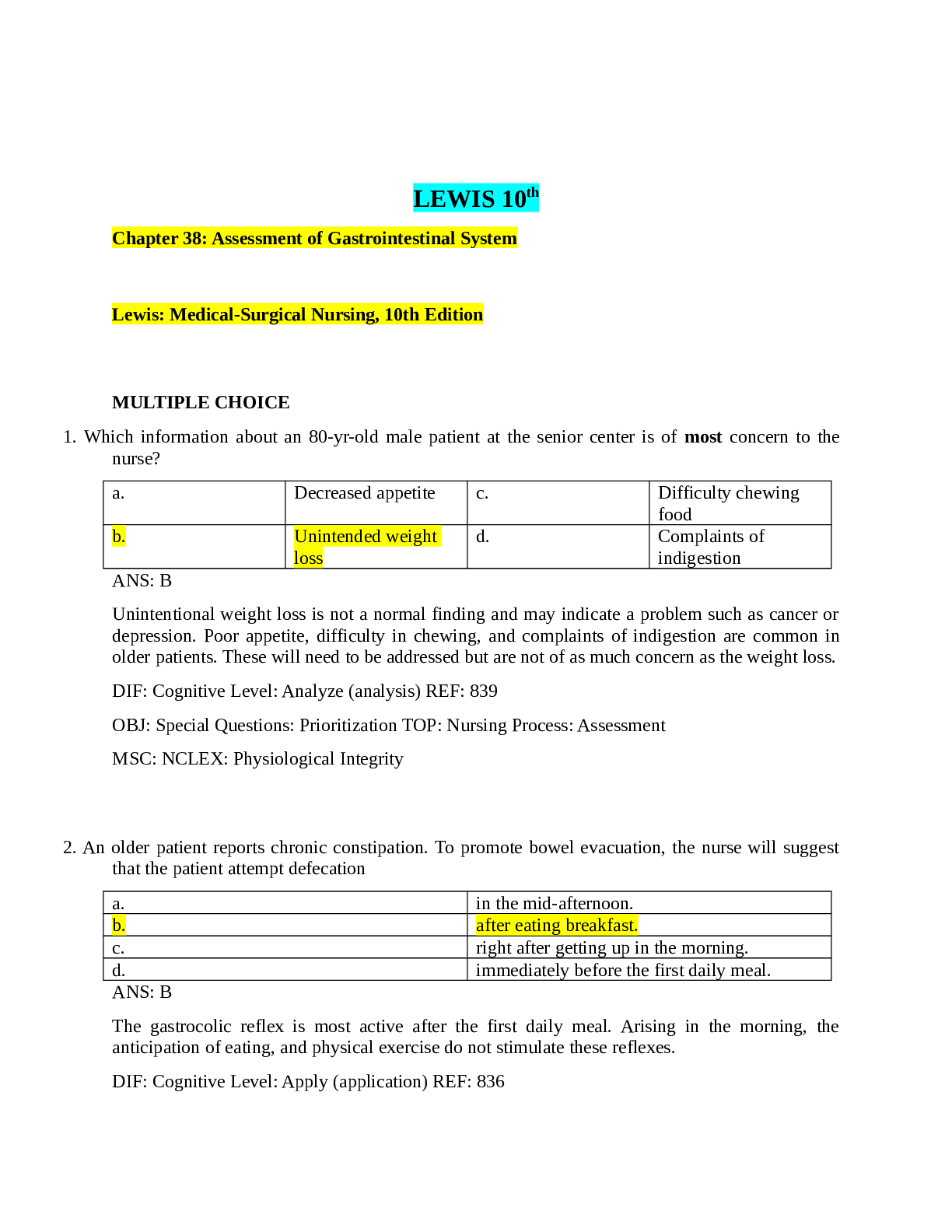
Reviews( 0 )
Document information
Connected school, study & course
About the document
Uploaded On
Oct 31, 2021
Number of pages
249
Written in
Additional information
This document has been written for:
Uploaded
Oct 31, 2021
Downloads
0
Views
55

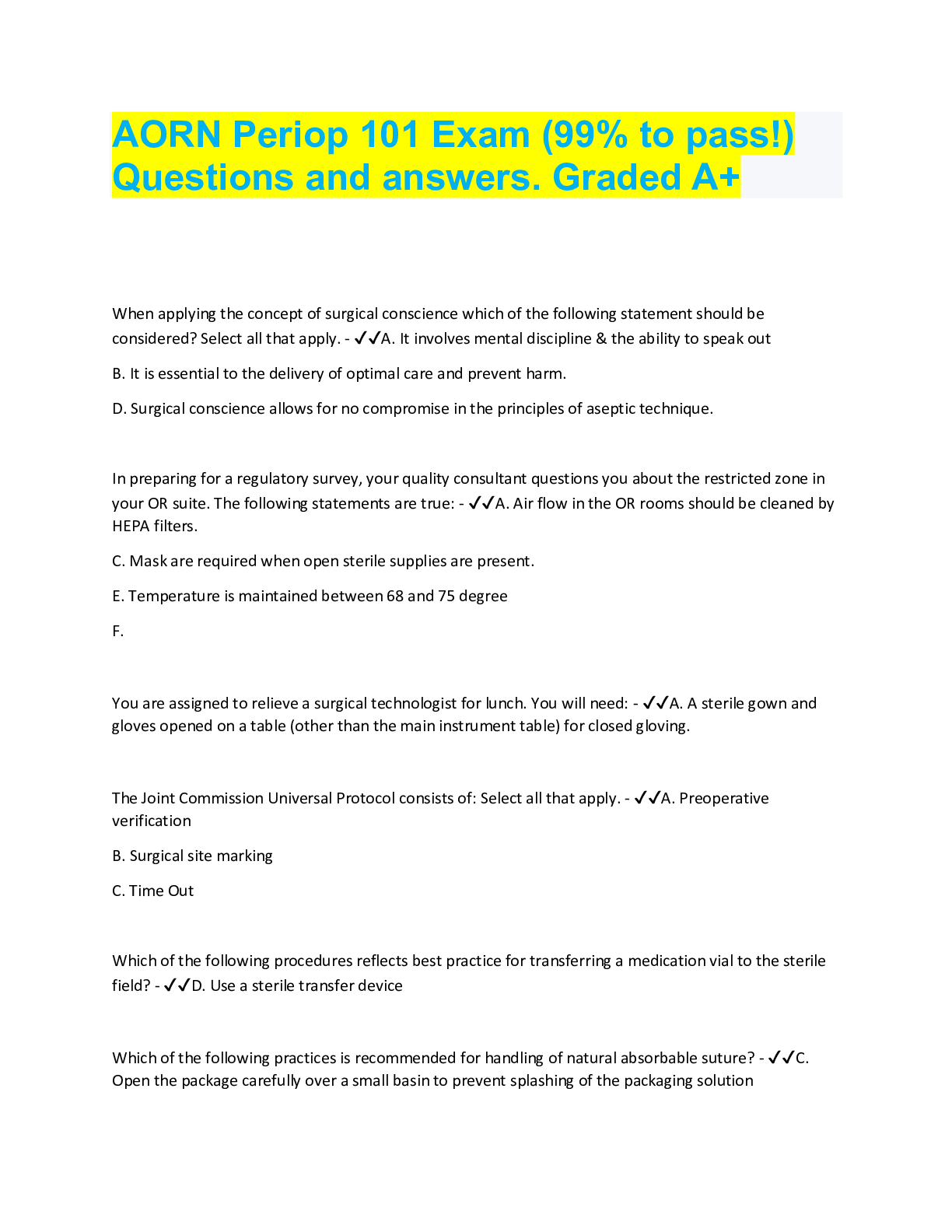
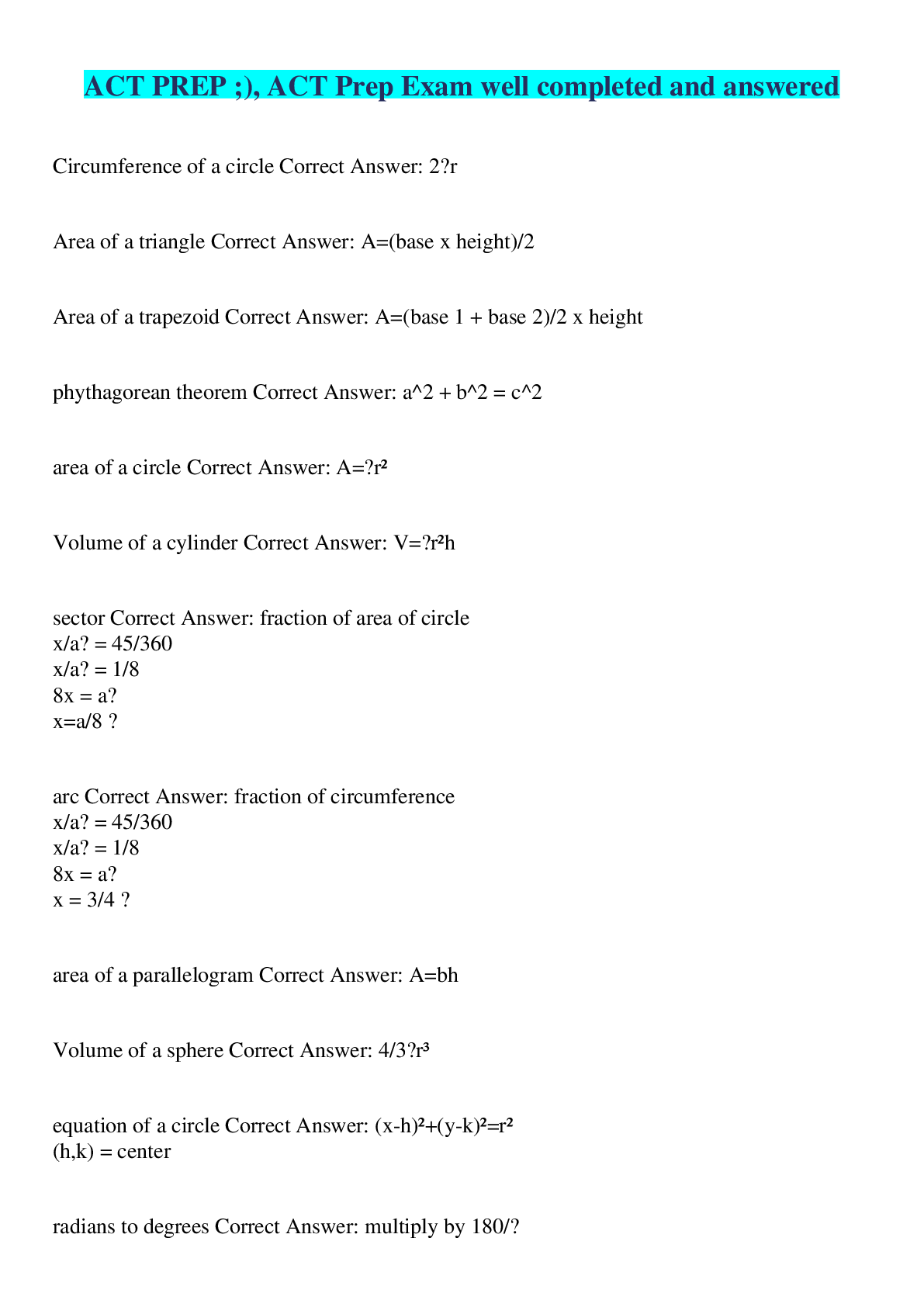
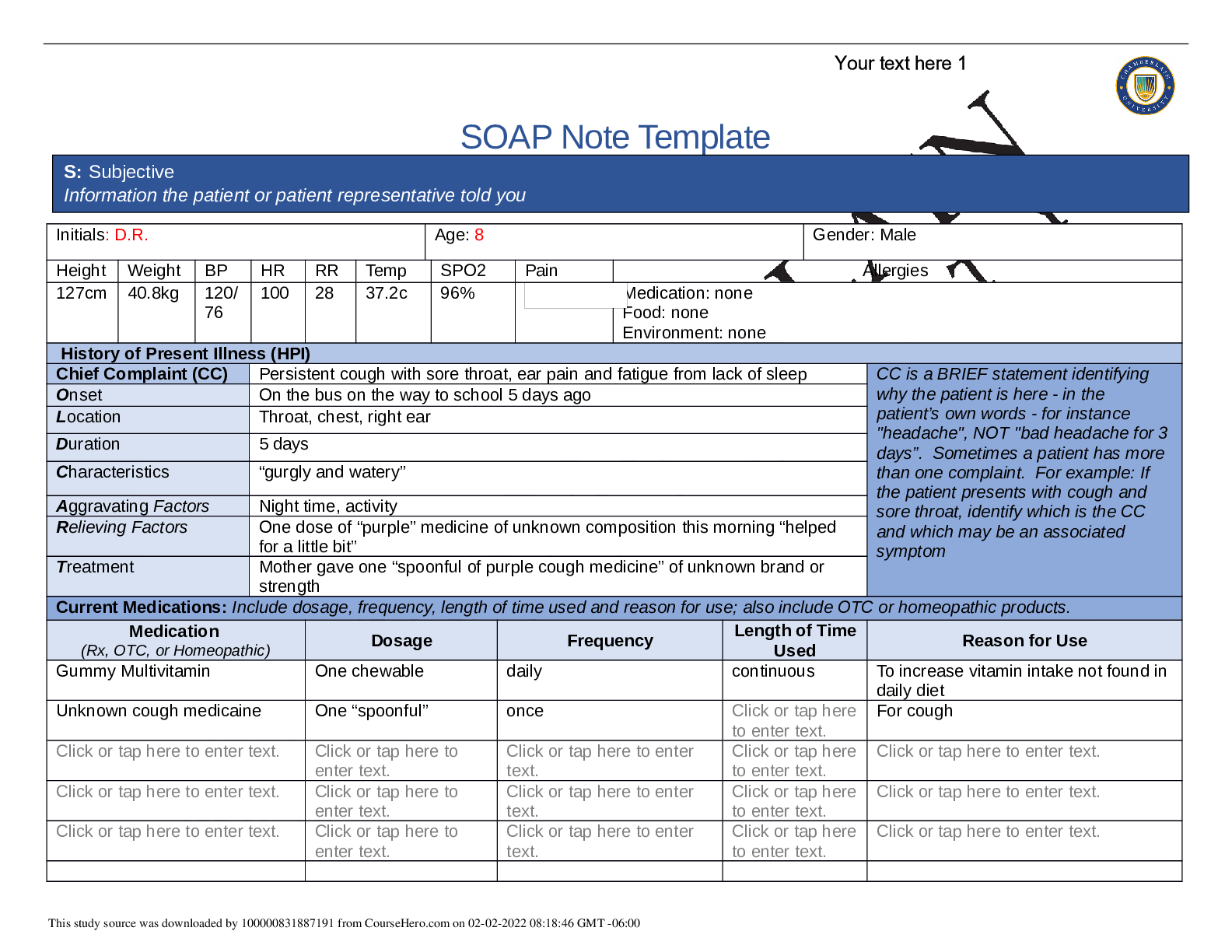
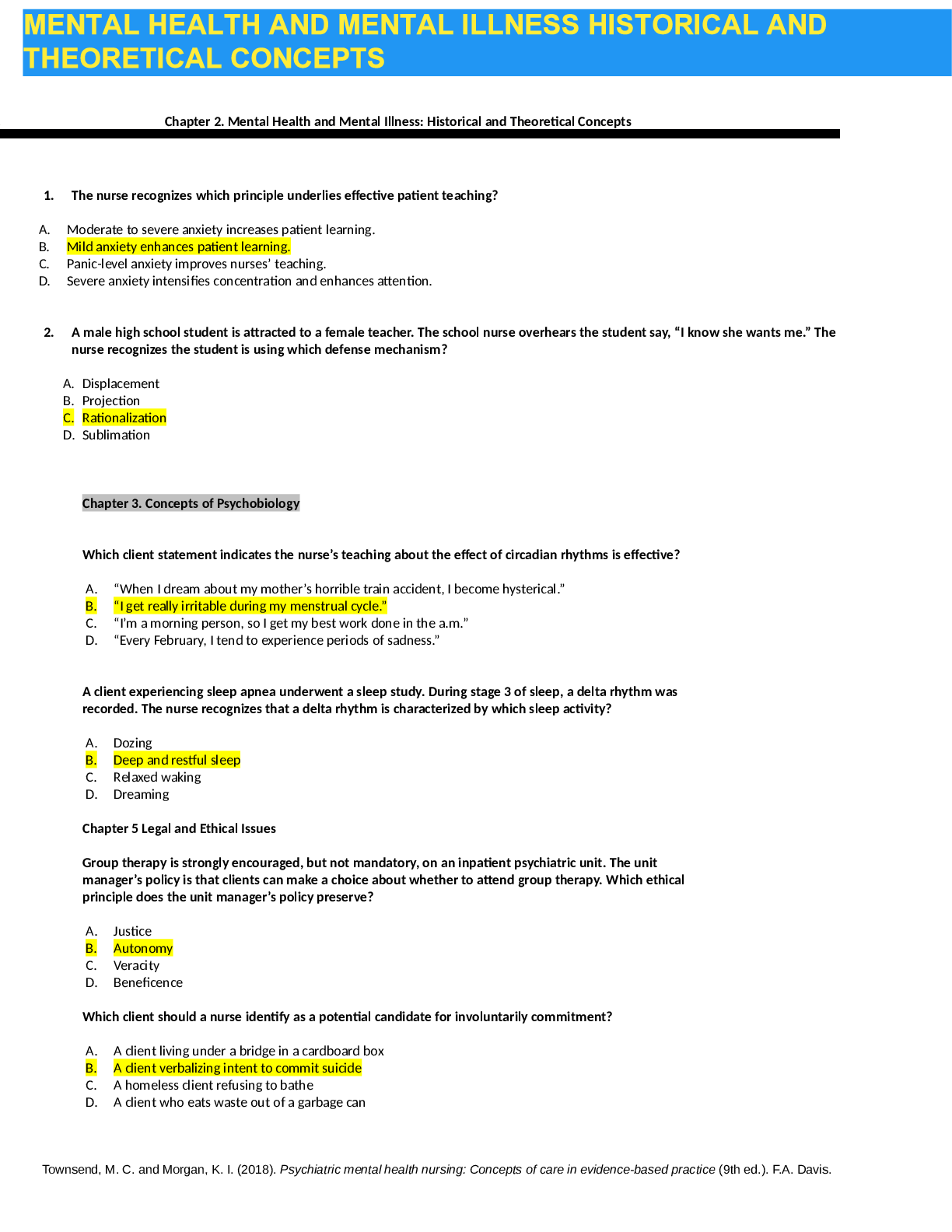

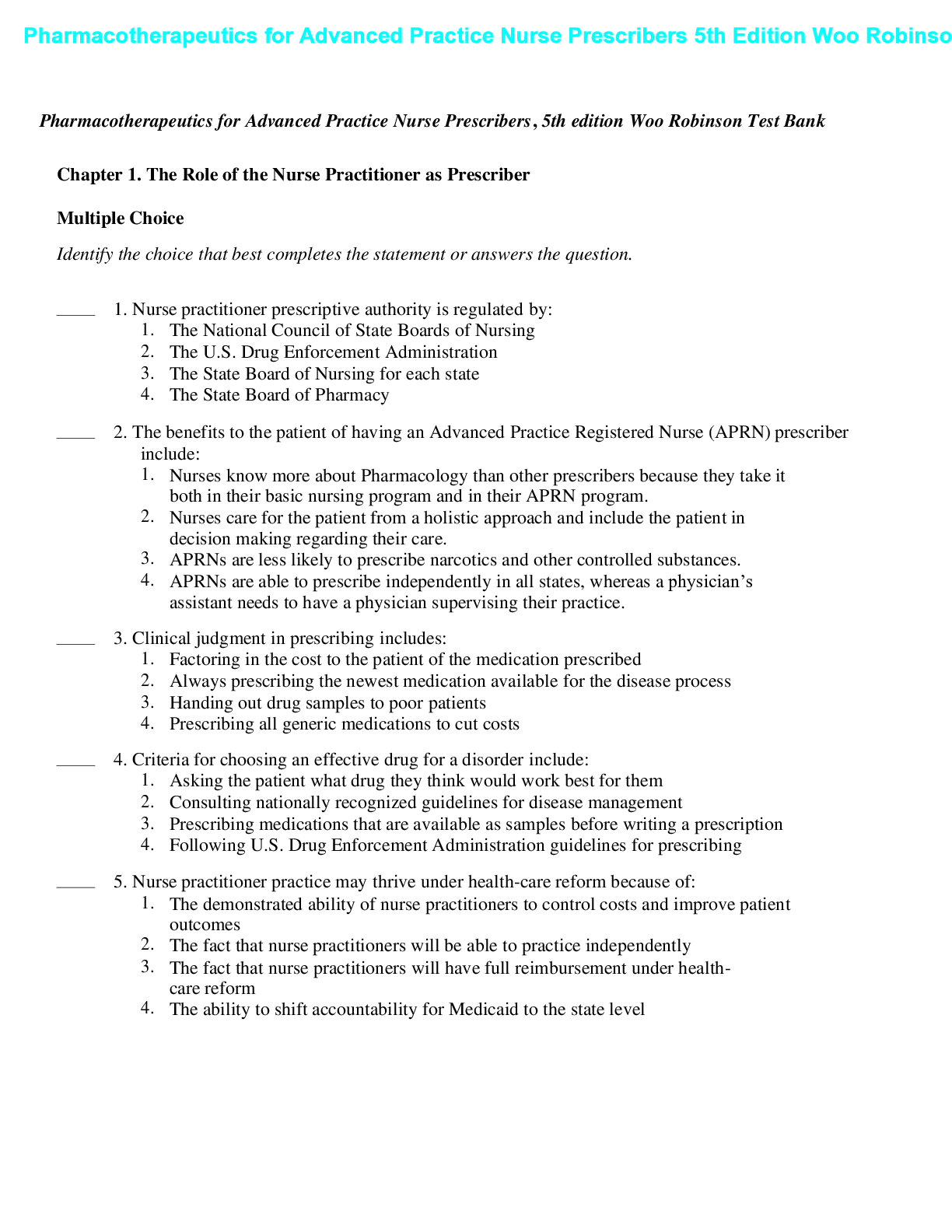
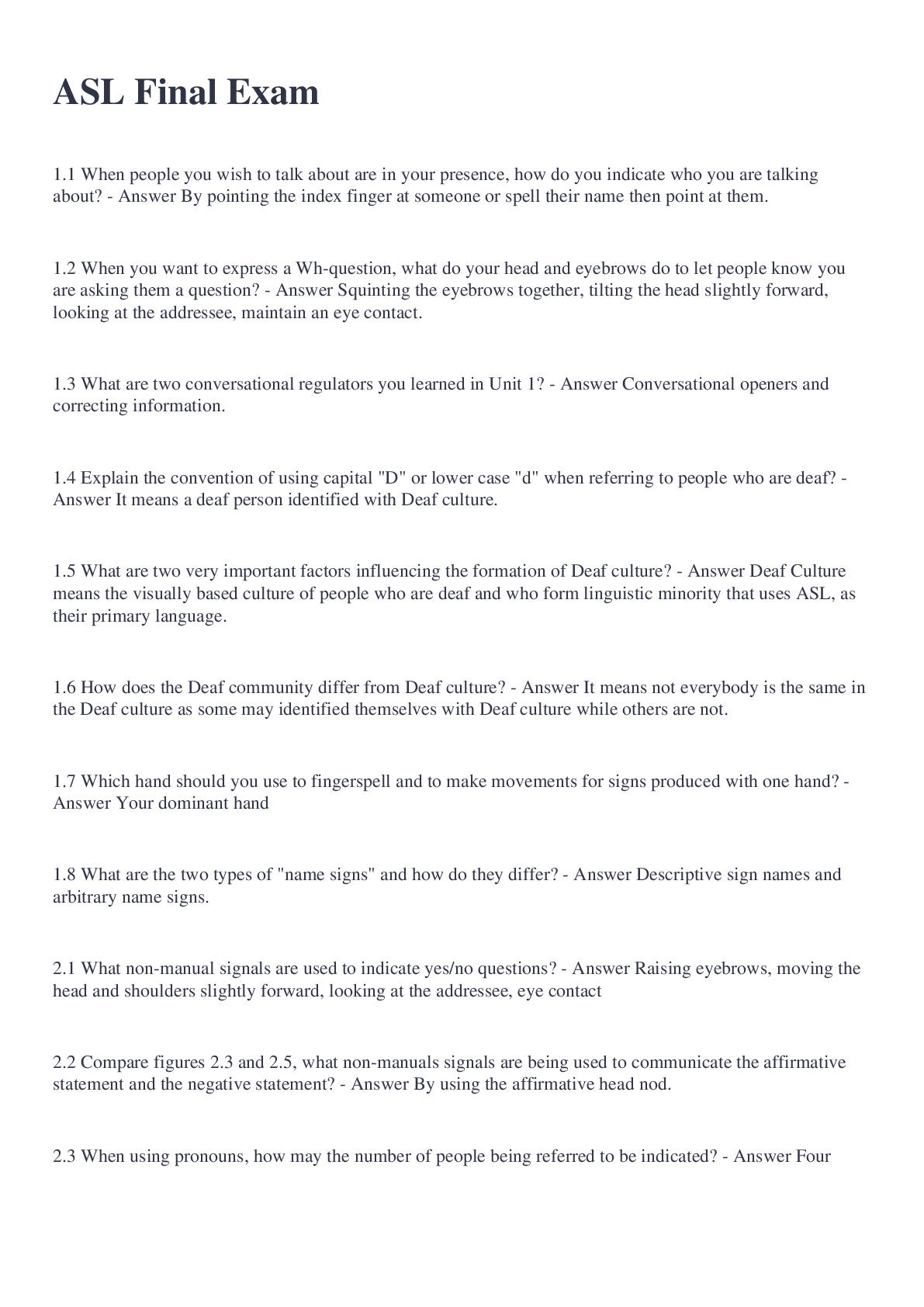
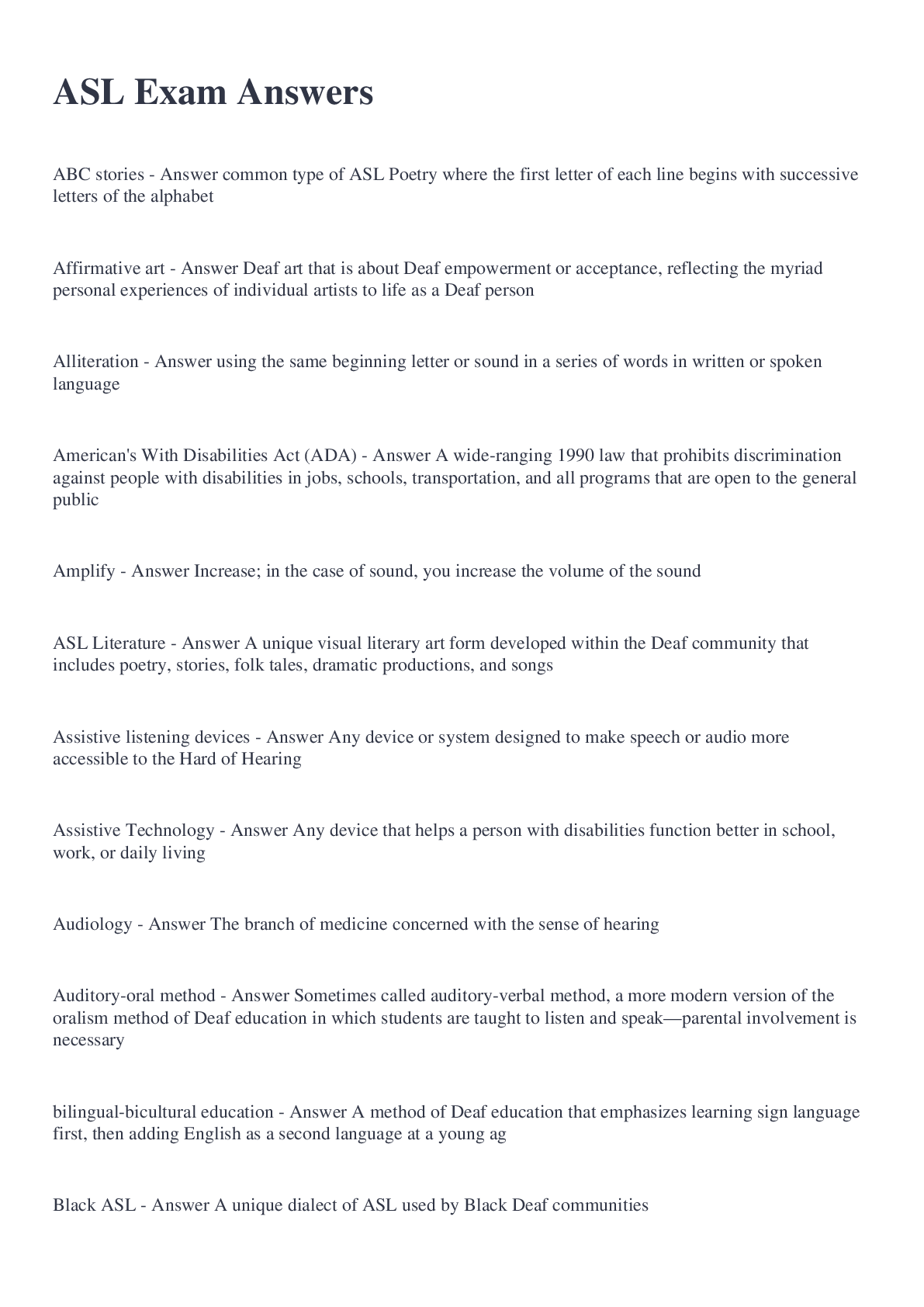

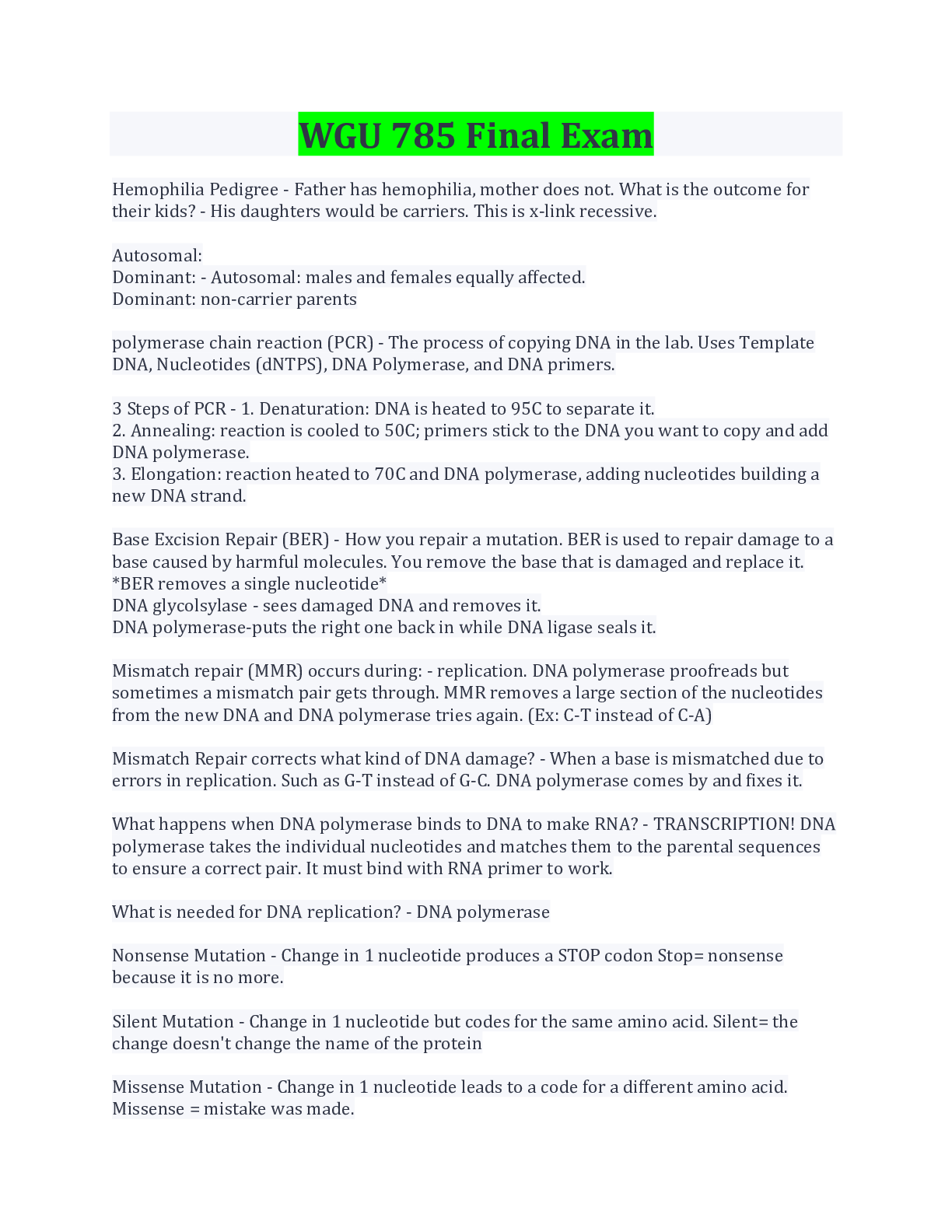
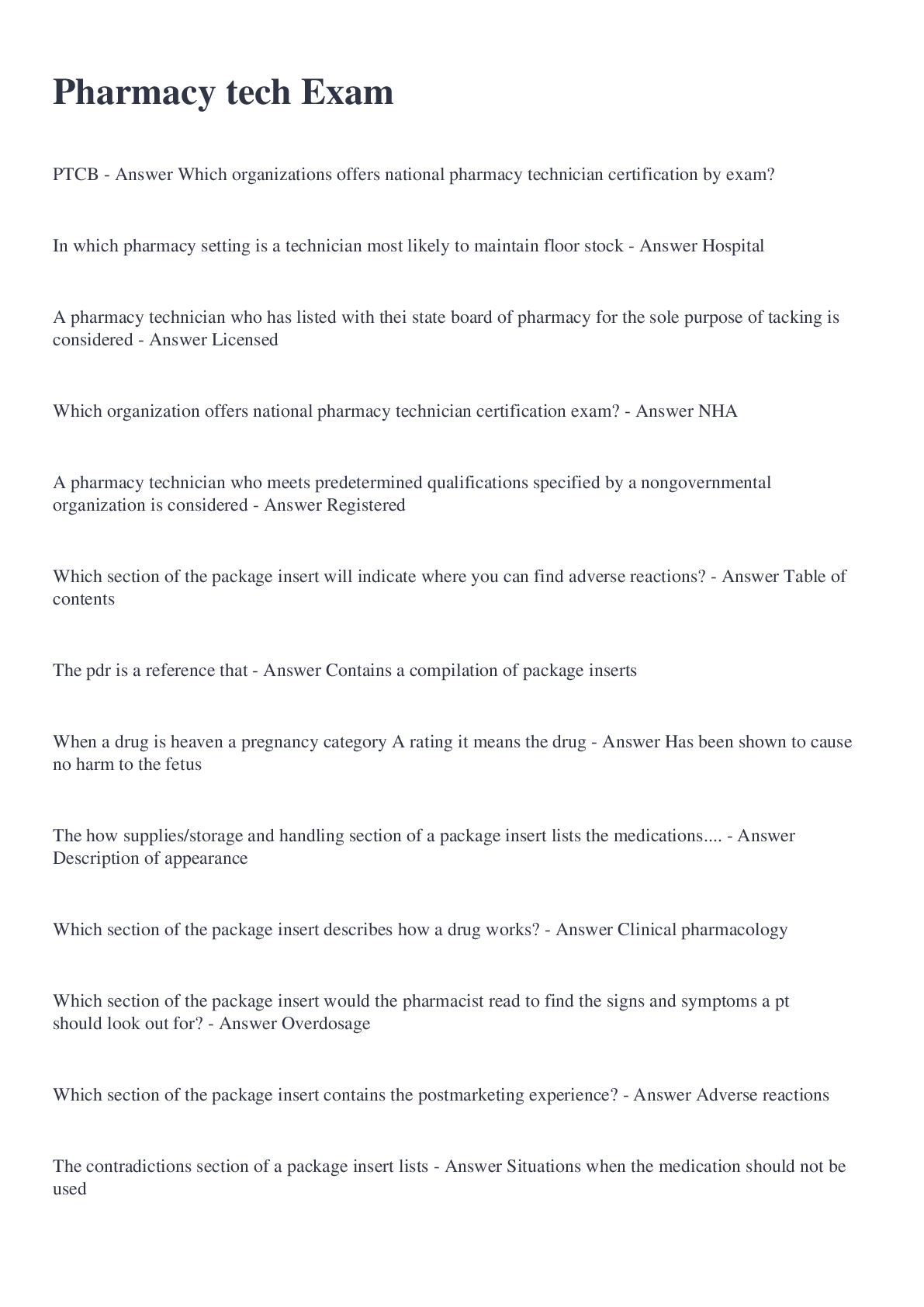
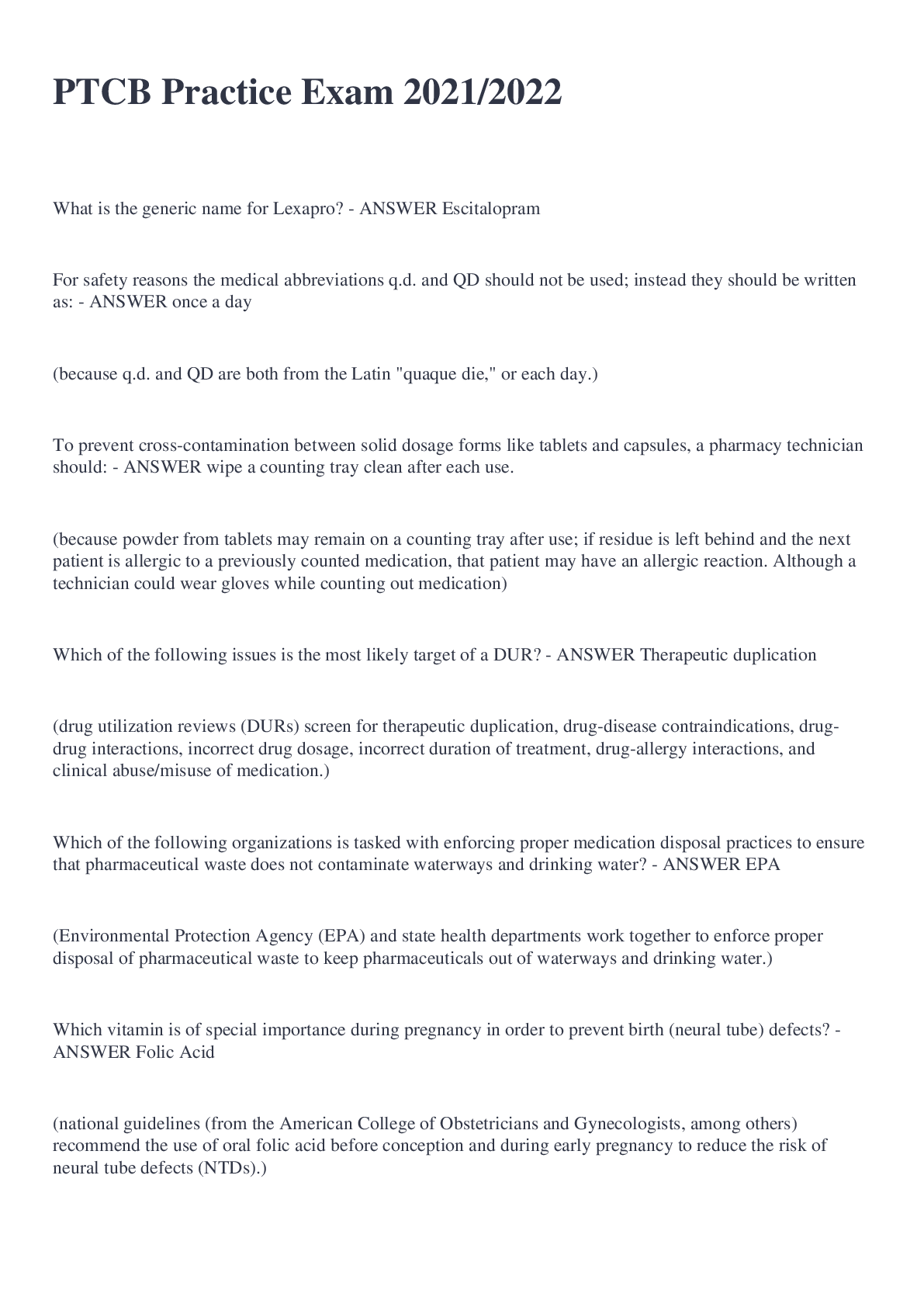
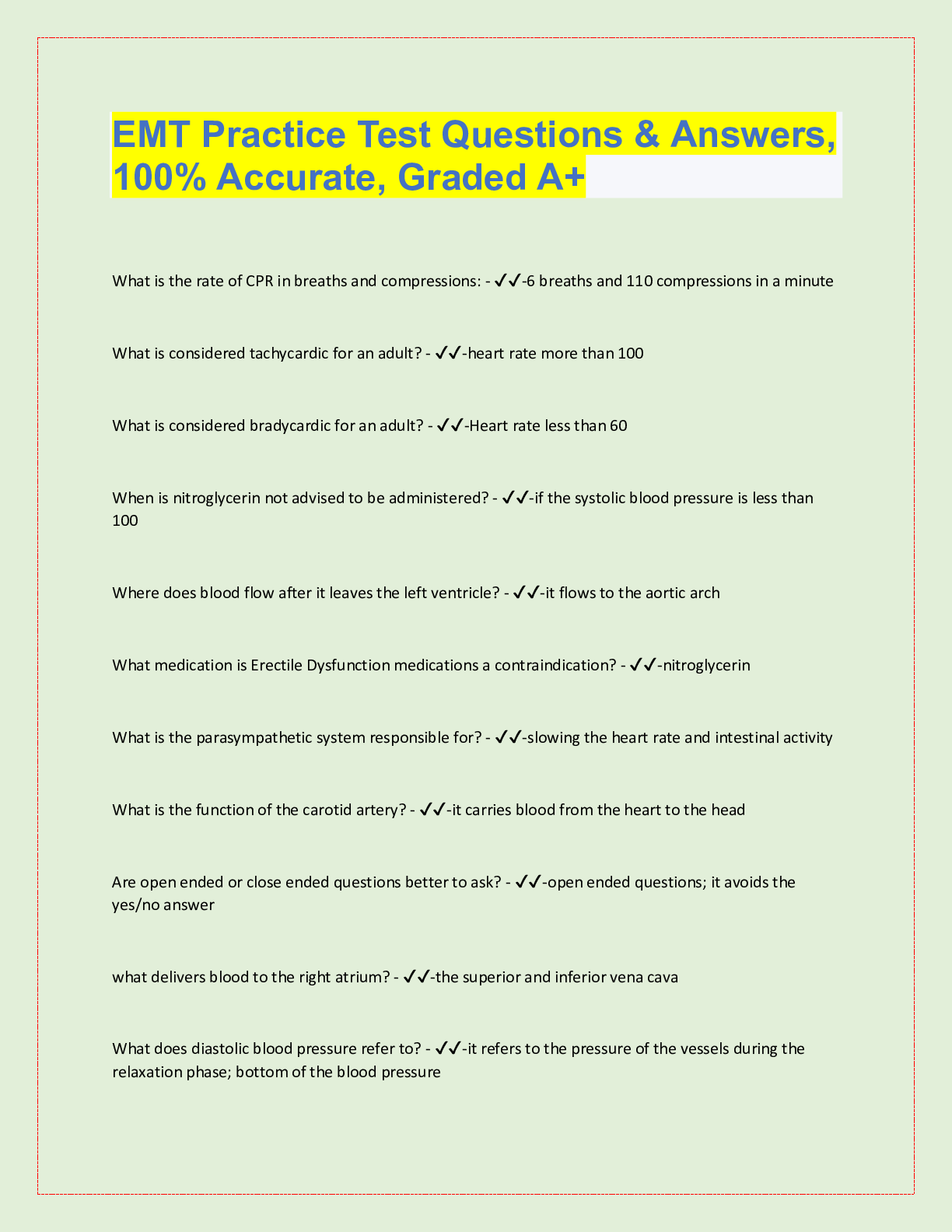
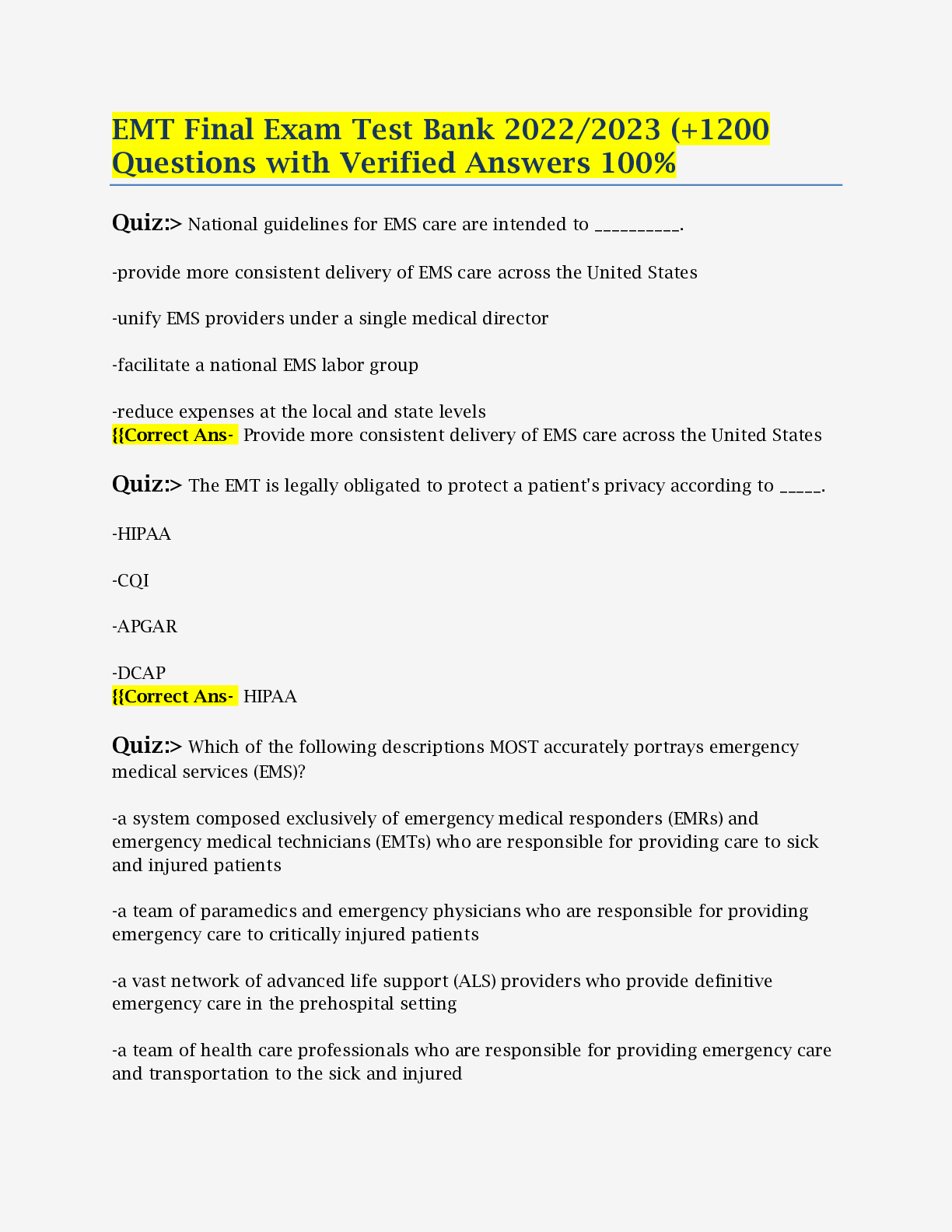
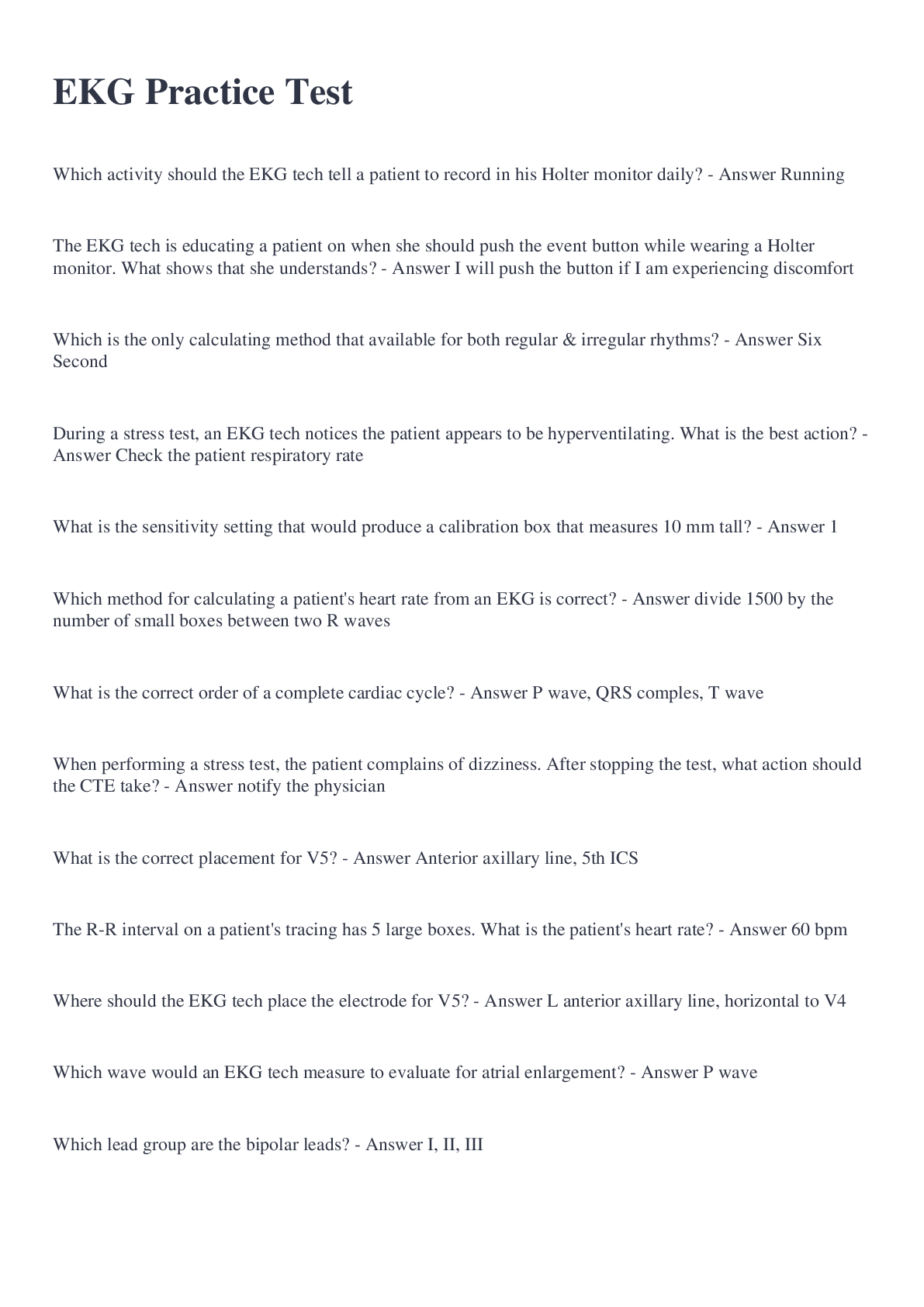
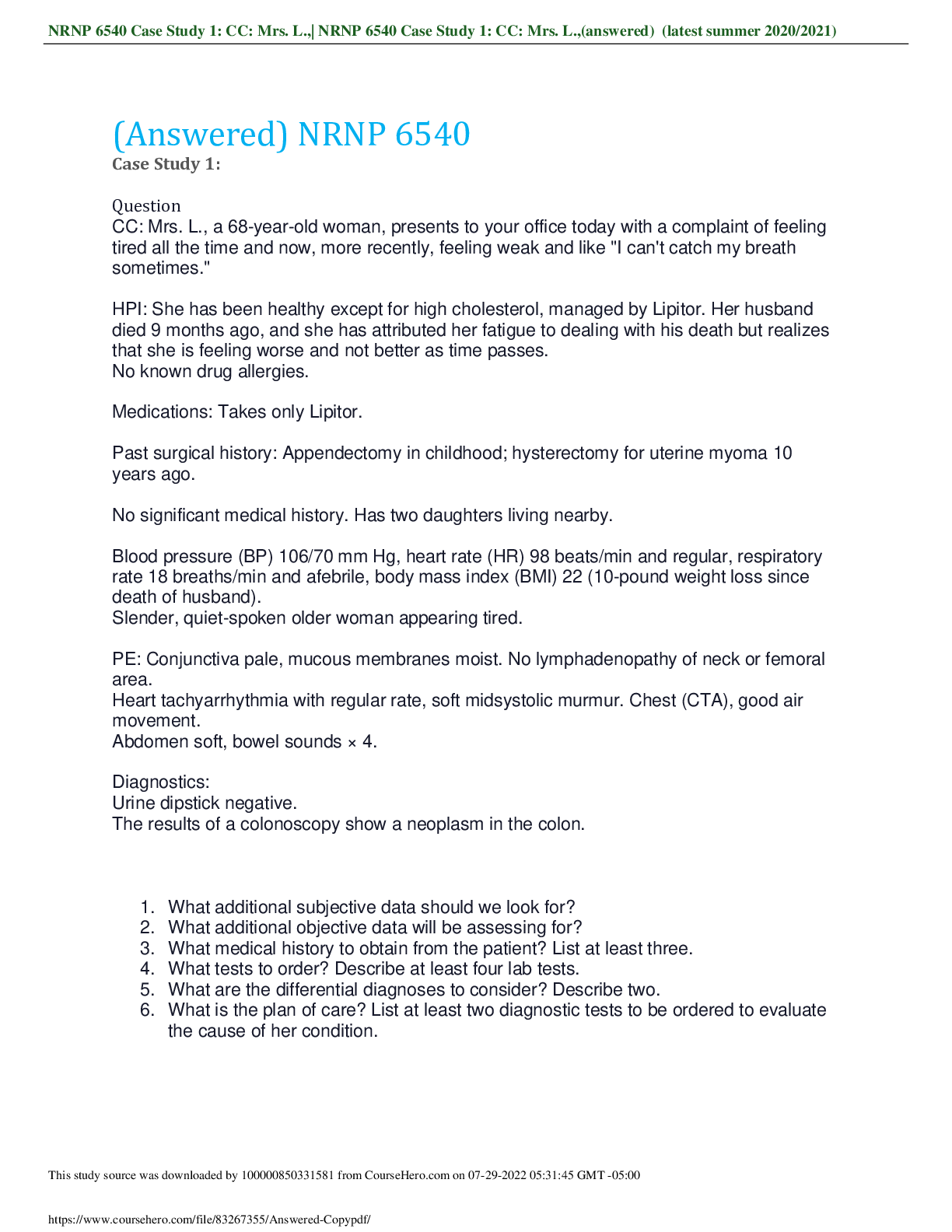
 (1).png)
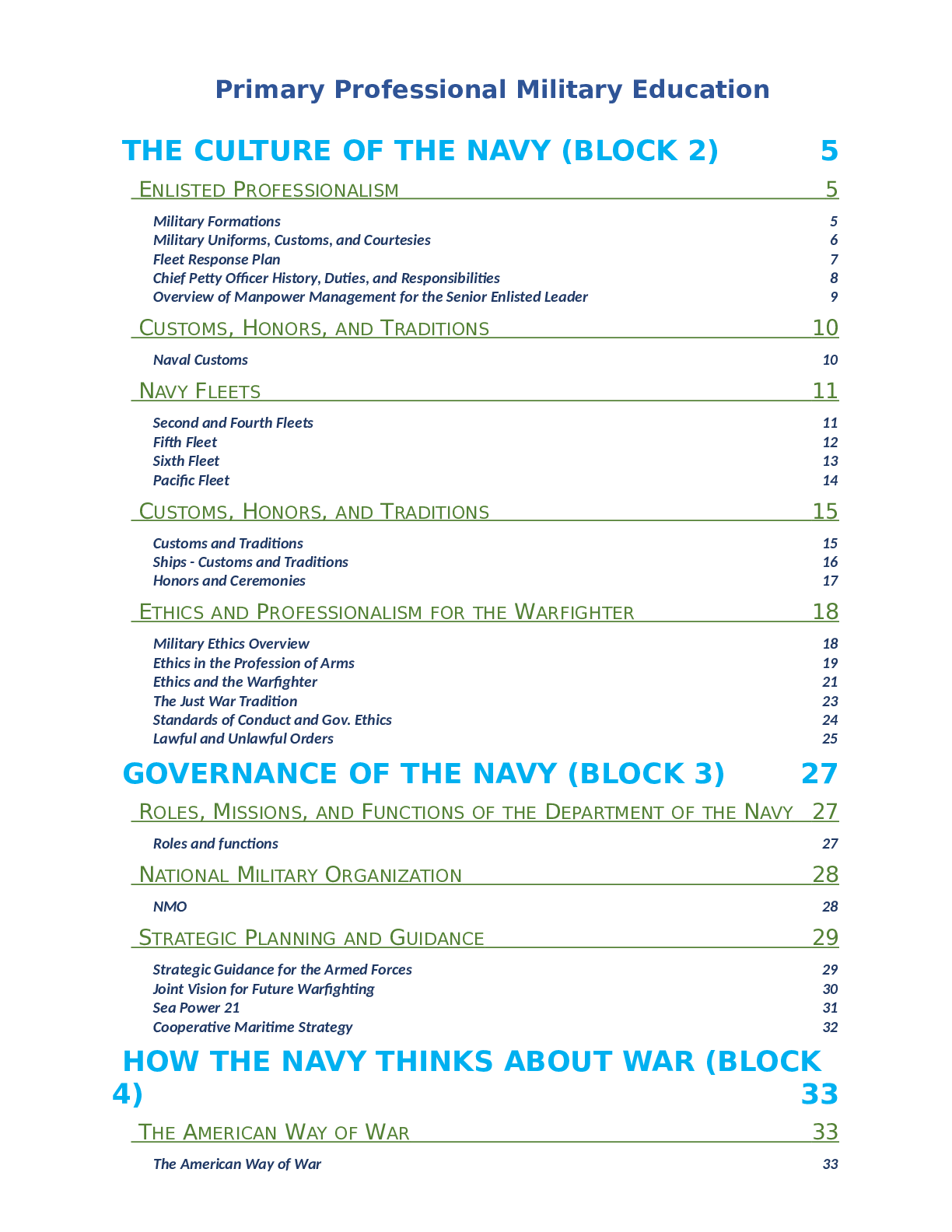
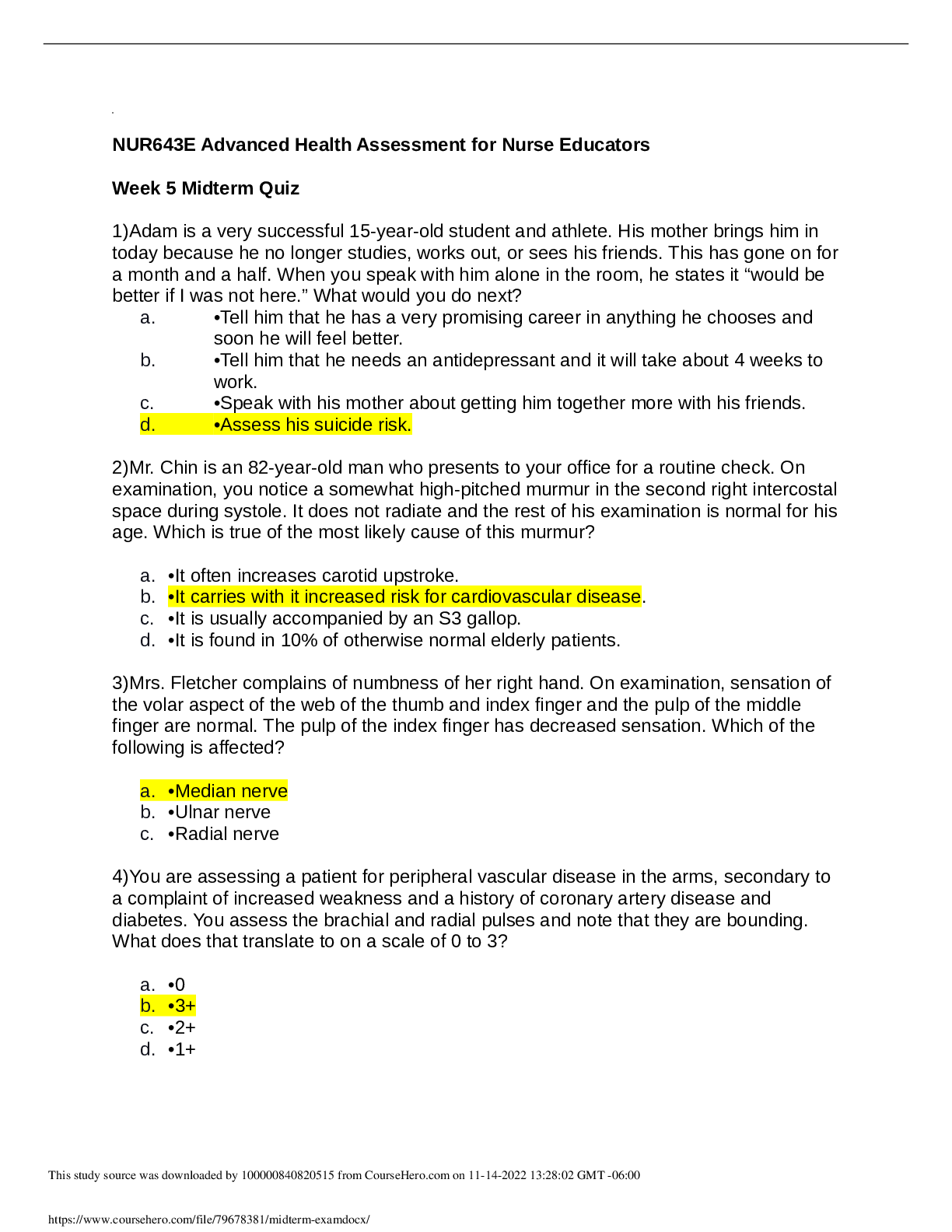
.png)
